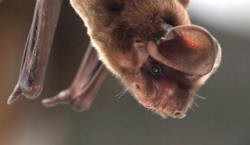|
 Miami
Bat Squad tracks rare species to golf course roost Miami
Bat Squad tracks rare species to golf course roost
 Send a link to a friend
Send a link to a friend
[September 16, 2014]
By Zachary Fagenson
MIAMI (Reuters) - Shortly
after dusk, three researchers squat on the lawn of a
vacant, million-dollar home in a posh Miami suburb,
pointing ultrasonic microphones at the darkened mansion. |
|
 They're part of the Miami Bat Squad, listening to track down the
home of the rare Florida bonneted bat - a critically endangered
species that has turned up at a nearby golf course. They're part of the Miami Bat Squad, listening to track down the
home of the rare Florida bonneted bat - a critically endangered
species that has turned up at a nearby golf course.
Scientists know little about the brown, snout-nosed creature, which
emits unusual audible noises as it flies and whose population is
believed to number only a few hundred. The bonneted bats exist only
in southern Florida.
But last week, the Miami Bat Squad announced that it had located
what is believed to be the first known roost of the rare creature in
decades.
The group, made up of about 200 volunteers, has been trying to find
the daytime home of the species since they were heard circling a
golf course in the upscale community of Coral Gables earlier this
year.

“I was on the back porch drinking a glass of wine and thought ‘Oh my
God, those are bats,'” said Florida International University
biologist Kirsten Bohn, who recognized their faint chirping after
she moved into the area recently.
Bohn has been leading efforts to locate precisely where the bats
roost by day, count their numbers and gather any other information
that could help preserve them. They were added to the U.S.
endangered species list last fall.
“This one is a special case, because so little is really known about
its habits,” said Ken Warren, a spokesman for the U.S. Fish and
Wildlife Service.
For the past several weeks, volunteers have walked the golf course
at dusk, watched trees and rooftops and listened for bat cries. To
rally the bat seekers, Miami-based spirits maker Bacardi Ltd, whose
bat logo pays homage to roosts in its Cuban distillery during the
late 19th century, supplied free drinks for one of the volunteer
events.
[to top of second column] |

Last week, the group narrowed down the roost to the posh house with
the red Spanish tile roof at the edge of the golf course. Now they
are working to find the precise location, and to try to ascertain
the number of bats in the colony.
On one recent evening, researchers tucked high frequency recorders
around the house. As Bohn listened for bat sounds measured by
computer software, a shadowy silhouette emerged from a crack in the
roof, then zipped overhead with a fast-pitched series of metallic
chirrups.
Bohn was ecstatic, and hopes to prove that the bat, which is thought
to live in groups of less than a dozen, may have been calling to
friends.
She and her graduate students debated whether to scale the house to
collect bat droppings to ship to a London-based analyst aiding their
effort, but decided to wait until morning.
“We know where they are now,” she said.
(Editing by Letitia Stein, David Adams and Eric Walsh)
[© 2014 Thomson Reuters. All rights
reserved.] Copyright
2014 Reuters. All rights reserved. This material may not be
published, broadcast, rewritten or redistributed.

 |